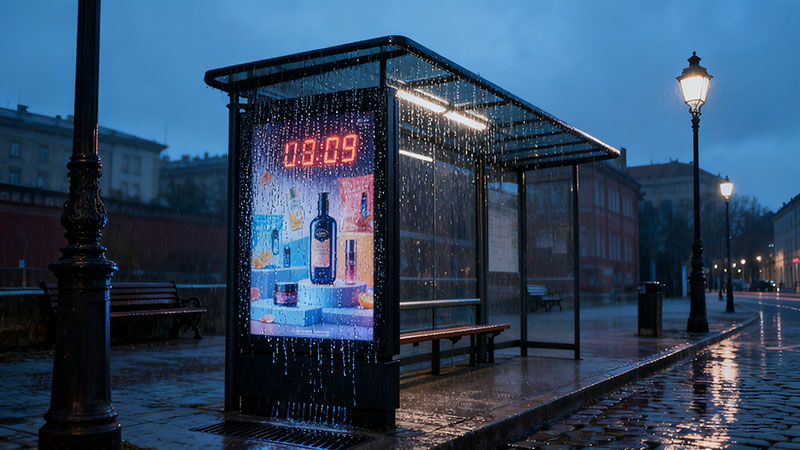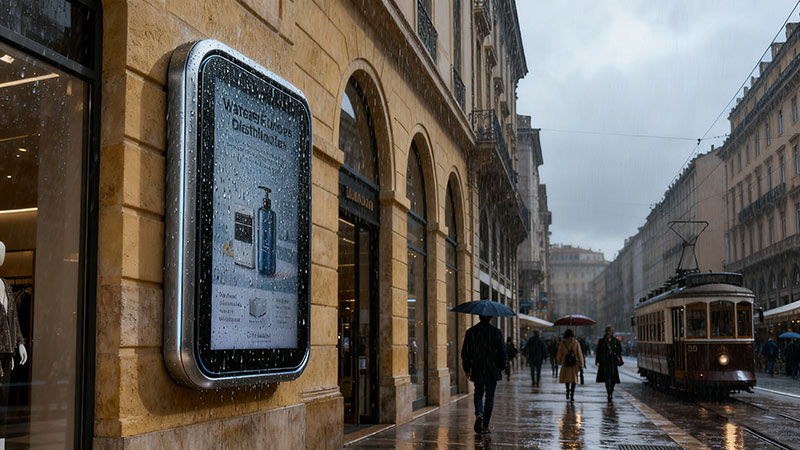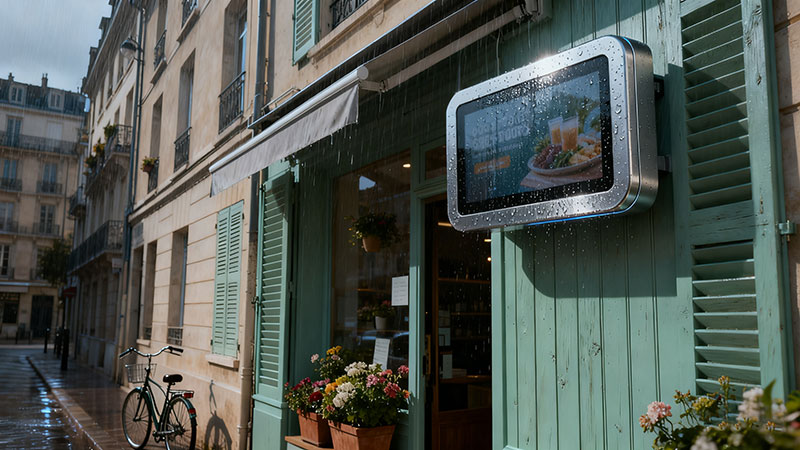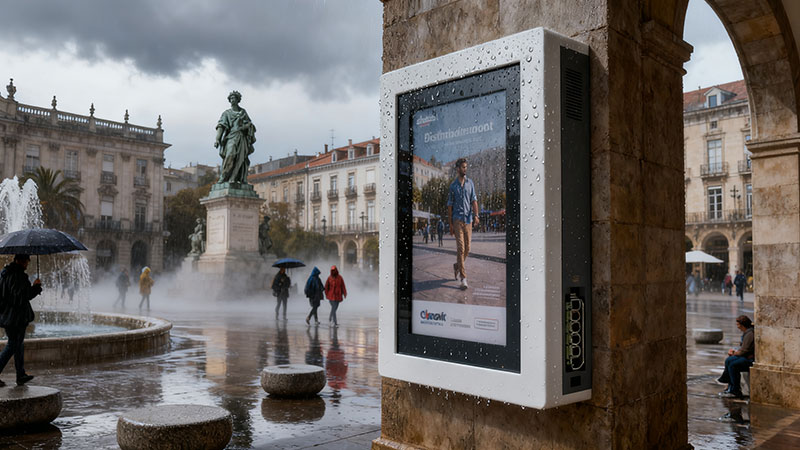Audience: European distributors and integrators
Purpose: Authoritative, technical, practical guide describing common outdoor waterproof digital signage sizes, recommended specifications, industry context, standards, integration advice, and how RisingStar (or your supply line) supports European projects with standard SKUs and full customization.
Length: Comprehensive (≈4,000+ words)

European demand for outdoor digital signage continues to grow as retailers, transport authorities, municipalities and DOOH operators upgrade static media to dynamic, programmatic content. Distributors need a product range that covers compact service displays (fuel pumps, EV chargers), standard storefront and kiosk sizes, and larger-location-impact formats — plus clear technical guidance so integrators can specify the correct brightness, ingress protection, thermal management and compliance for European deployments.
This document gives you:
a concise catalogue of industry-standard sizes (and when to use each);
technical spec guidance (recommended nits, IP classes, operating temperature, life, mounting and optics choices);
relevant standards & certification touchpoints for Europe;
integration, installation & maintenance best practices; and
commercial & go-to-market tips for European distribution.
Where helpful, industry figures and standards references are cited so you can use them in specification documents and bids.
Europe’s digital signage market is sizeable and growing: recent market research estimates the European digital signage market value in the multiple billions USD range with steady growth through the 2020s. This growth is driven by retail digital transformation, transport infrastructure modernization (passenger information displays), and programmatic DOOH. As a distributor, this means demand exists across a spectrum of projects — from small-scale kiosks to large outdoor installations — and your product mix must match that breadth.
Business implication: stock and promote a laddered SKU set (small → mid → large) and offer fast customization for projects where non-standard sizes or environmental requirements are mandated.
Below are the sizes you should list in catalogues and keep available for quick quoting. Each size is paired with typical applications and a short “spec trigger” (what specifications to double-check before quoting):
10″, 12″, 15″, 21.5″, 24″
Use cases: Fuel dispensers, EV charger displays, vending machine UI, wayfinding posts, interactive buttons, payment terminals.
Spec triggers: Touch (projected capacitive or resistive), glove use, glove mode; IP65/66 enclosure for pump canopy; anti-glare optically bonded glass.
Why stock: Many pump/charger OEMs require compact screened modules; fast replacement units are a differentiator.
32″, 43″, 49″, 55″
Use cases: Retail window displays, bus stop kiosks, street-level portrait posters, small-square format DOOH.
Spec triggers: 2,500–3,500 nits for direct sun; portrait/landscape mounting kits; vandal-resistant glass and tamperproof mounting.
Why stock: “Workhorse” sizes — used in the majority of retail & transit projects.
65″, 75″, 86″
Use cases: Large-ticket city kiosks, transit concourse signage, outdoor POI (points of interest) displays and plaza installations.
Spec triggers: Structural wind load analysis, service access, heat dissipation and power provisioning; consider optional higher nits (up to 5,000) for extreme sunlight.
Why stock: Provide larger visual impact and are requested for higher dwell environments (stations, malls).
Custom dimensions, tiled modular LED or tiled LCD video walls (meter-scale)
Use cases: Building façades, highway billboards, stadium displays.
Spec triggers: Pixel pitch, module size, cabinet IP rating, synchronization hardware, local authority advertising permits.
Why offer customization: Many DOOH advertisers and municipalities require bespoke footprints, pixel pitches and brightness profiles; being able to deliver custom solutions wins large tenders.
Example product practice: several established outdoor LCD suppliers list mid-range models at 2,500 nits for 32–55″ and 2,500–5,000 nits for flagship models in 55–86″ sizes. Vendors also offer protective enclosures rated IP65/IP66 and touch options for 43–86″ units.
The correct specifications remove risk of returns and field failures. Below are the most critical technical parameters, how they matter, and a recommended European baseline.
What it is: Nits (candela per square meter) measure luminance. Outdoor readability depends on ambient illuminance and content contrast.
Guidance: For European outdoor installations:
Semi-outdoor / shaded locations: 500–1,000 nits (roofed bus stops, under canopies).
Direct sunlight / window displays: 1,500–3,000 nits as a working baseline.
High-sunlight / direct tropical sun or highly reflective windows: consider 3,500–5,000 nits or higher, combined with optical bonding and anti-reflective coatings.
Why it matters: Under-specified brightness makes content illegible, while over-specifying drives costs and thermal engineering needs.
What it is: The IEC IP rating defines protection against solids and liquids (dust, jets, immersion).
Recommendation for most outdoor signage: IP65 minimum for exposed outdoor displays (protection against water jets and dust ingress). IP66–IP67 considered where high-pressure cleaning or temporary immersion risk exists. Use IP67 for kiosks that might see submersion during flooding or where cleaning practices demand it.
Why it matters: IP rating ties directly to warranty, serviceability and service intervals for coastal or high-rainfall locations.
Operating temperatures: −20°C to +50°C baseline for many European climates; extend to −30°C / +60°C if alpine or direct-sun in summer. Opt for industrial-grade components and thermal management (heat pipes, fans, or heater elements for cold climates).
Humidity & condensation mitigation: Conformal coatings on PCBs or controlled internal desiccants.
Why it matters: Thermal stress reduces backlight lifetime and leads to color/brightness drift.
Direct-lit (full-array) LED backlight provides higher and more uniform brightness than edge-lit panels at high nits. For sunlight-readable LCDs, many suppliers use direct downlight LED arrays engineered for high luminance while controlling power draw.
Optical bonding: reduces internal reflections, improves contrast and ruggedizes the panel for vandal resistance.
Anti-glare & anti-reflective coatings: critical for window-facing and high-glare streetscapes.
High brightness is necessary but not sufficient: contrast ratio and dynamic gamma control improve legibility. For critical passenger information displays and retail, insist on contrast ratios >1000:1 where possible and configurable gamma curves for outdoor content.
Backlight lifetime baseline: 50,000 hours typical for industrial high-brightness LCDs (rated to B50 L70 depending on backlight tech). Provide explicit brightness-vs-time decay curves for tender responses.
MTBF & component sourcing: Specify industrial components (e.g., wide-temp rated power supplies, commercial-grade controllers) to support 24/7 operation and long service cycles.

To operate and sell displays in the EU and UK markets, pay attention to these regulations and standards:
Electromagnetic Compatibility (EMC): EN standards such as EN 55032 (CISPR 32) apply to multimedia equipment and are commonly expected for displays sold in Europe. Testing for conducted and radiated emissions and immunity is required to affix CE marks in many product classes.
Low voltage / safety: Compliance with relevant EN/IEC safety standards for equipment is expected.
IEC/EN 62368-1 (replacement for older AV/IT safety standards) is widely used for audio/video, information and communication technology equipment. Ensure power supplies and internal wiring meet applicable editions and national variations.
Ingress / enclosure testing: IEC IP rating tests are the baseline for all outdoor enclosures; maintain test reports for IP claims.
Local municipal permits and advertising laws: Outdoor DOOH often requires local permits. Distributors should proactively advise integrators on municipal rules and provide documentation for wind loading, glare/illumination, and electrical safety for permit applications.
RoHS, REACH compliance: for materials and restricted substances.
UL and national equivalents: UL 62368-1 or local product safety approvals help on projects that touch utility or transit operator procurement. (Note: UL standards and editions evolve — check the current edition for tender compliance).
Below are short, realistic specification recipes you can present to European clients. Each is a compact “spec sheet” for typical project archetypes.
Size: 55″ or 65″ portrait
Brightness: 2,500–3,500 nits (window facing, direct sun)
IP rating: IP65 (display), IP54 accessible behind window if installed indoor→outdoor protected
Features: Optical bonding, anti-reflective glass, portrait mounting kit, ambient light sensor, dimming control
Rationale: Brightness must overcome sunlight through glass; optical bonding reduces ghost reflections.
Size: 10″–15″ (primary UI) + optional 21.5″ secondary advertising display
Brightness: 800–1,500 nits (under canopy typical) or 2,500 nits if fully exposed
IP rating: IP66 for enclosure (high-pressure wash), tamperproof mounting, glove-capable touch
Features: Payment terminal integration, EMI filtering, conformal coating
Rationale: Safety and ingress protection are paramount; serviceability for pump networks is critical.
Size: 43″ or 55″ landscape, possibly 65″ for high-dwell stops
Brightness: 1,500–2,500 nits (sheltered to partially exposed)
IP rating: IP65, with louvered vents to manage condensation
Features: PoE options (where supported), remote monitoring (SNMP), failover content player
Rationale: Reliability and centralized monitoring reduce field service costs.
Size: 75″ or 86″ (landscape or portrait), possibly dual-sided
Brightness: 2,500–5,000 nits depending on exposure
IP rating: IP66/67 (Vandal & weather protection) with tamper-resistant housings
Features: Heated enclosures for winter climates, modular replaceable panels for servicing
Rationale: High public exposure and variable weather require robust mechanical design.

To reduce project risk and TCO, advise your integrator partners to follow these best practices:
Wind load & mounting: For large formats (>55″) always provide wind-load calculations for the mounting scheme and include anchor and backplate details that comply with local building codes.
Service access: Design displays with front serviceability or modular front-replaceable modules; back-access only units add lift and permit complexity.
Anti-vandal measures: Use laminated or tempered glass with tamper screws and recessed mounting where applicable.
Power provisioning: Specify inrush current (cold start) for high-brightness models because LED backlights and heaters draw significant startup current.
Thermal management: For cold climates include heaters; for warm climates provide adequate heat rejection (venting or active cooling). Include temperature-based brightness control to protect components.
Remote management: Offer remote monitoring (SNMP or cloud portals), content failover and watchdogs that automatically switch to local cached content if connectivity fails.
Media players & DRM: For DOOH networks, support common media player standards (Android/Windows/Linux players) and provide options for secure DRM.
Service level agreements: Offer tiered SLA options (on-site replacement, advance swap, depot repair) — European customers expect defined SLAs.
Spares policy: Recommend keeping at least one spare panel or power module for every 20–50 installed units depending on criticality and location.
Documentation: Provide an installation pack with electrical diagrams, environmental test reports, ingress test certificates and mounting drawings for permitting.
Your value to European clients is not only product but speed and configurability. Here are practical commercial levers to offer.
Maintain inventory of:
32″ (high-brightness), 43″, 55″ (2–3 brightness options), 65″ (1–2 brightness options).
Accessories: mounting frames, IK/vandal covers, sun hoods, networked media players.
Bespoke dimensions & faceplates: for kiosks and EV islands.
Brightness tuning: deliver tuned units to project brightness targets (e.g., 2,500 / 3,500 / 5,000 nits).
Touch variants: projected capacitive for multi-finger gestures vs. resistive for gloved operations.
Enclosure certification: ability to deliver IP66/67 and IK10-rated housings for high-risk areas.
Offer tiered warranties — 36 months standard, 60 months premium (with service credits).
Bundle content & management services for recurring revenues (content scheduling, monitoring).
Clearly itemize environmental options (heaters, cooling kits, optical bonding) as optional extras — they materially change cost and lead time.

Use the following points (with attached evidence) to make specifications robust and defensible in RFPs:
Market growth: cite Europe digital signage market research to justify rollouts and ROI modeling.
Ingress protection principles: reference IEC IP rating criteria when arguing for IP65/66/67 minimums in outdoor tenders.
Brightness baselines: include recommended nit ranges for “semi-outdoor vs direct-sun” so tender reviewers understand tradeoffs (BenQ / display guidance).
Product examples: reference competitor product pages as matching examples of market-standard sizes and brightness (useful when customers ask “what others use”).
EMC & multimedia standards: include EN 55032 (CISPR 32) references for EMC expectations in EU procurement.
When distributors sell to retailers, municipalities or transit authorities, the business case is stronger if you help quantify benefits:
Reduced cost of media change vs printed posters (print + installation). Digital offers greater frequency and programmatic revenue opportunities.
Higher CTR and targeted campaigns — DOOH campaigns can deliver dynamic, time-of-day advertising that commands premium CPMs in Europe’s major cities.
Operational savings — centralized updates reduce field visits; remote monitoring cuts mean time to repair.
Use market figures (cited earlier) to model adoption and potential ad revenue uplift on new deployments.
RisingStar supplies a complete range of industrial-grade outdoor waterproof displays — from 10″ modules for fuel pumps and EV chargers through 32″–55″ storefront systems to 65″–86″ plaza kiosks and fully custom video-wall façades. Our units meet IP65/IP67 classes, are sunlight-readable up to 5,000 nits, use optical bonding and direct LED backlights for long 50,000-hour life, and are available with OEM/ODM customization, CE/EMC documentation and European service agreements. We partner with integrators to provide mounting, thermal engineering, and field spares to ensure fast, reliable rollouts across the EU.
Use that as the first paragraph in outreach emails or catalogues.
Q: What brightness do we need for London vs. Mediterranean Spain?
A: London (often overcast) can use 1,500–2,500 nits for many outdoor spots; southern Spain with high sun will often need 3,000–5,000 nits for direct sunlight. Consider optical bonding and anti-glare coatings in both.
Q: IP65 or IP67 — which to specify?
A: IP65 is adequate for most exposed signage (jets, heavy rain). Use IP67 when there's flood/immersion risk or when installers expect temporary submersion during maintenance.
Q: How to reduce field failures?
A: Use industrial thermal designs, choose front-serviceable modules, and deploy remote monitoring with proactive alerts. Keep a defined spare parts pool.
If you are distributing RisingStar (or equivalent industrial display supplier), emphasize these practical capabilities:
SKU ladder: keep the core 32″/43″/55″/65″ SKUs across multiple brightness options in stock.
Rapid customization: offer bespoke frames, faceplates and brightness tuning with clear lead-times.
Compliance docs: provide CE/EMC/EN test reports, IP test certificates and environmental test reports with every tender.
European SLA & spares strategy: offer depot and on-site options, and advice on spare ratios based on deployment criticality.





Ask a quote for the latest price and one of our team members will respond as soon as possible.
